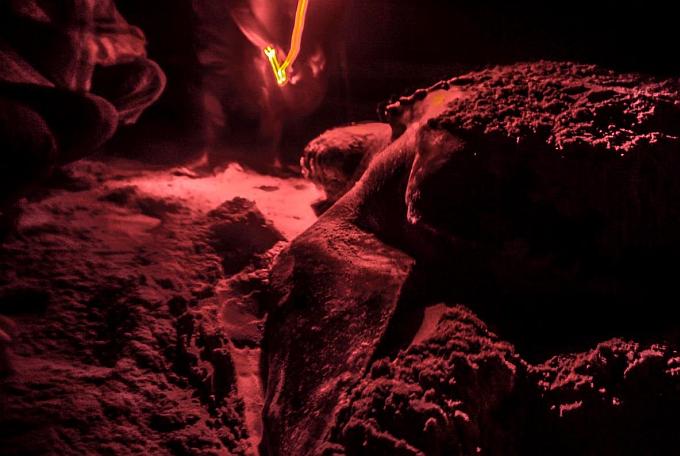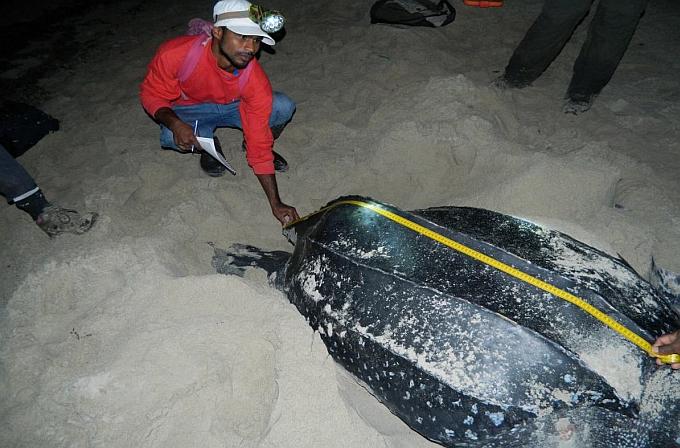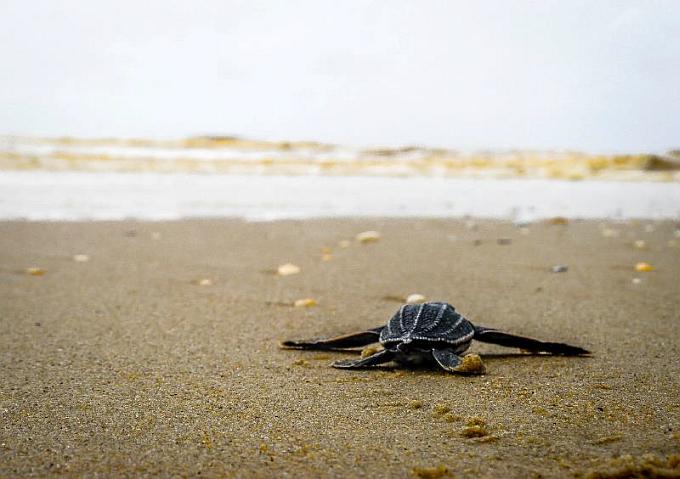Last year Hannah Davidson reported on the work of Glasgow University’s Exploration Society in Trinidad studying nesting Leatherback Turtles. Part of this research was on nest camouflaging and a summary of their findings is presented here.
Introduction
The leatherback sea turtle, Dermochelys coriacea, is the largest and most widely spread sea turtle in the world. Commonly known as the lute or leathery turtle, it is the only living species of the Dermochelyidae family. Following recent review the leatherback sea turtle was re-classified by the International Union for the Conservation of Nature (IUCN) in 2013 as vulnerable. With six sub-populations being individually assigned classifications, though this seems promising for the future of this species, they are still under substantial threat.
Trinidad is home to the one of the largest rookeries for leatherback turtles in the world with an estimated population of 6000 leatherback turtles per year. The Trinidad Expedition 2014 of Glasgow University Exploration Society were interesting in looking into the “sand scattering/camouflaging” phase of the Leatherback Turtle nesting. It is a not well understood phase, the actions of the turtle appearing to have very little direction or purpose. The turtle will begin with large, simultaneous and forceful front flipper movements which flick sand over and behind her body. This will be repeated with each movement followed by side to side “swishing movements” of the rear flippers which scatter the sand behind and around her body. These flipper actions do not occur at the same time but can occur several times within a movement event. She will then use her front flippers to move herself forward or use both sets of flippers to change her orientation in the sand. The team designed an experiment to investigate the movements of turtles upon the beach during the sand scattering phase of the leatherback nesting process.
Methodology
Using fairly a fairly simplistic yet effective methodology the team were able to successfully monitor in detail the movements of the turtle during the sand scattering phase. The study took place on the east coast of Trinidad at Fishing Pond beach with the help and guidance of the local NGO Turtle Village Trust (TVT). For a period of 10 weeks between June and August, a team of four would head off to the chosen site and walk the beach from 8pm until 1am searching for suitable subjects. For optimum data collection the turtle would have been observed from excavation stage until she returned to sea. The turtle would be observed carefully from the start of the sand scattering phase and all movements, defined as the turtle moving more than a metre or changing her orientation more than 90 degrees, were recorded. This enabled the collection of the following data:
- Nest depth before laying
- Nest depth after laying
- Duration of sand scattering phase
- Duration of each movement
- Length of each movement
- Orientation of turtle at the start of each movement


Using bamboo sticks with reflective ribbon individual movements were tracked in the sand. The time taken, orientation and distance between these movements were measured and a detailed map was drawn to represent the turtles chosen path. The team were always careful to not disturb the turtle, using only red lights when needed.
Results and Discussion
The team managed to observe 17 turtles in 2014 and combined with data from 2012, this gave a samples size on 26 observations. The analysis of the drawings showed that these turtles travel a considerable distance during the sand scattering phase (mean = 13.45m, n=26) which results in a very large area of disturbed sand on the beach (30.3m). The maximum distance ever travelled from the nest was 5.88m and the average end distance from the nest was 5.04m.
Of all the individuals studied, eight measurements of nest depth were collected. Seven measurements of around 75cm and one of a shallower 66cm. Changes in the depth of the nest caused by the sand throwing occurring during the sand scattering phase were also recorded. Nest depth increased by a mean of 5.4 cm (range = 1.5 - 14 cm) due to the sand throwing of the sand scattering phase.
The function of sand scattering has never been universally accepted though normally referred to as camouflaging. Miller (1997) has a view that this phase primarily functions to cover the nests with sand and to “re-establish the environment around the nest”, that this covering of the nest provides insulation for the eggs beneath it and helps the eggs retain their moisture. The findings of this study do not support this theory. The area of sand disturbed is far greater than that of the nest site itself and importantly the centroid of the disturbed area is some distance from the nest site (mean = 3.05 m). To support Miller’s theory, it would be expected that the centroid of the disturbed area of sand would be much closer to the nest itself. Furthermore the change of the depth of the nest as a result of sand scattering actions was both variable (range = 1.5-14 cm) and not substantial (mean = 5.4 cm), especially given the considerable temporal investment in this phase. That such an increase in sand cover would provide the increased insulation for the nest suggested by Miller seems unlikely.



